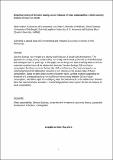Files in this item
Empirical testing of Genuine Savings as an indicator of weak sustainability : a three-country analysis of long-run trends
Item metadata
| dc.contributor.author | Hanley, Nicholas David | |
| dc.contributor.author | Oxley, Les | |
| dc.contributor.author | Greasley, David | |
| dc.contributor.author | McLaughlin, Eoin | |
| dc.contributor.author | Blum, Matthias | |
| dc.date.accessioned | 2016-06-17T23:32:43Z | |
| dc.date.available | 2016-06-17T23:32:43Z | |
| dc.date.issued | 2015 | |
| dc.identifier | 194821906 | |
| dc.identifier | 97114fc8-1008-46c1-a984-01bb4791676e | |
| dc.identifier | 84957840382 | |
| dc.identifier | 000369314800006 | |
| dc.identifier.citation | Hanley , N D , Oxley , L , Greasley , D , McLaughlin , E & Blum , M 2015 , ' Empirical testing of Genuine Savings as an indicator of weak sustainability : a three-country analysis of long-run trends ' , Environmental and Resource Economics , vol. In press . https://doi.org/10.1007/s10640-015-9928-7 | en |
| dc.identifier.issn | 0924-6460 | |
| dc.identifier.uri | https://hdl.handle.net/10023/9012 | |
| dc.description | The authors thank The Leverhulme Trust for funding this work under the project “History and the Future: the Predictive Power of Sustainable Development Indicators” (Grant Number F00241). | en |
| dc.description.abstract | Genuine Savings has emerged as a widely-used indicator of sustainable development. This approach to conceptualising sustainability has strong links to work published by Anil Markandya and colleagues over 20 years ago. In this paper, we use long-term data stretching back to 1870 to undertake empirical tests of the relationship between Genuine Savings (GS) and future consumption for three countries: Britain, the USA and Germany. Our tests are based on an underlying theoretical relationship between GS and changes in the present value of future consumption. Based on both single country and panel results, we find evidence supporting the existence of a cointegrating (long-run equilibrium) relationship between GS and future consumption, and fail to reject the underlying basic theoretical result on the relationship between these two macroeconomic variables. These findings provide some support for the GS measure of weak sustainability. | |
| dc.format.extent | 1072155 | |
| dc.language.iso | eng | |
| dc.relation.ispartof | Environmental and Resource Economics | en |
| dc.subject | Weak sustainability | en |
| dc.subject | Genuine Savings | en |
| dc.subject | Comprehensive investment | en |
| dc.subject | Economic history | en |
| dc.subject | Sustainable development indicators | en |
| dc.subject | Cointegration | en |
| dc.subject | HB Economic Theory | en |
| dc.subject | 3rd-DAS | en |
| dc.subject.lcc | HB | en |
| dc.title | Empirical testing of Genuine Savings as an indicator of weak sustainability : a three-country analysis of long-run trends | en |
| dc.type | Journal article | en |
| dc.contributor.institution | University of St Andrews. Geography & Sustainable Development | en |
| dc.identifier.doi | https://doi.org/10.1007/s10640-015-9928-7 | |
| dc.description.status | Peer reviewed | en |
| dc.date.embargoedUntil | 2016-06-18 | |
| dc.identifier.url | http://link.springer.com/content/esm/art:10.1007/s10640-015-9928-7/file/MediaObjects/10640_2015_9928_MOESM1_ESM.docx | en |
This item appears in the following Collection(s)
Items in the St Andrews Research Repository are protected by copyright, with all rights reserved, unless otherwise indicated.

